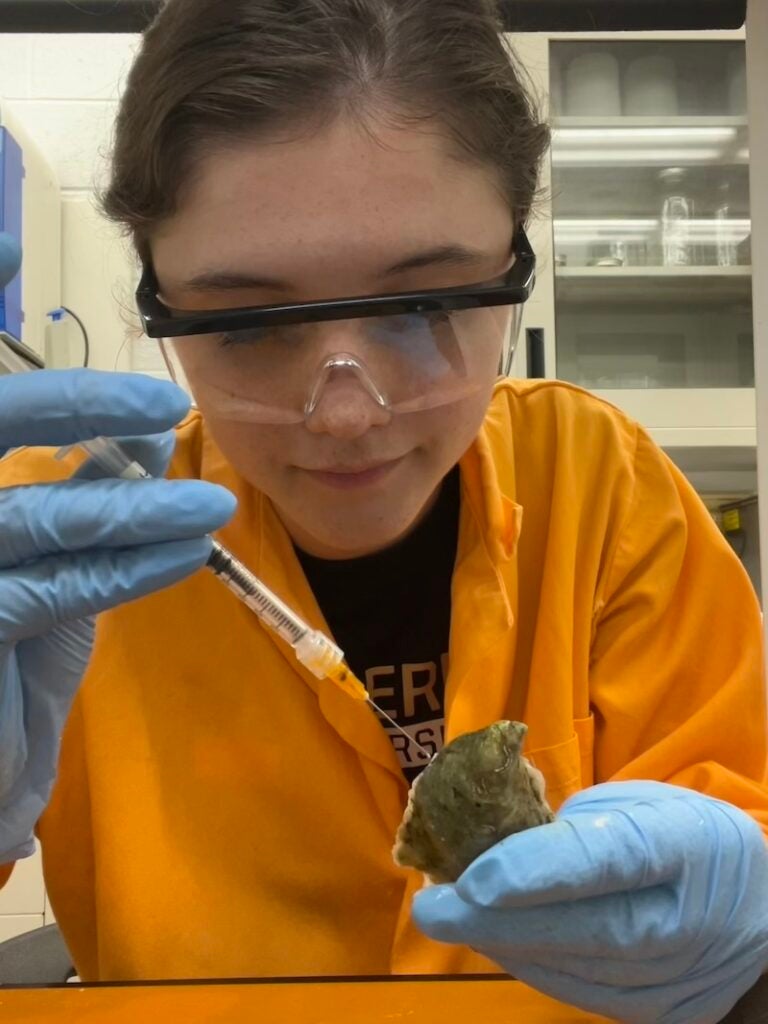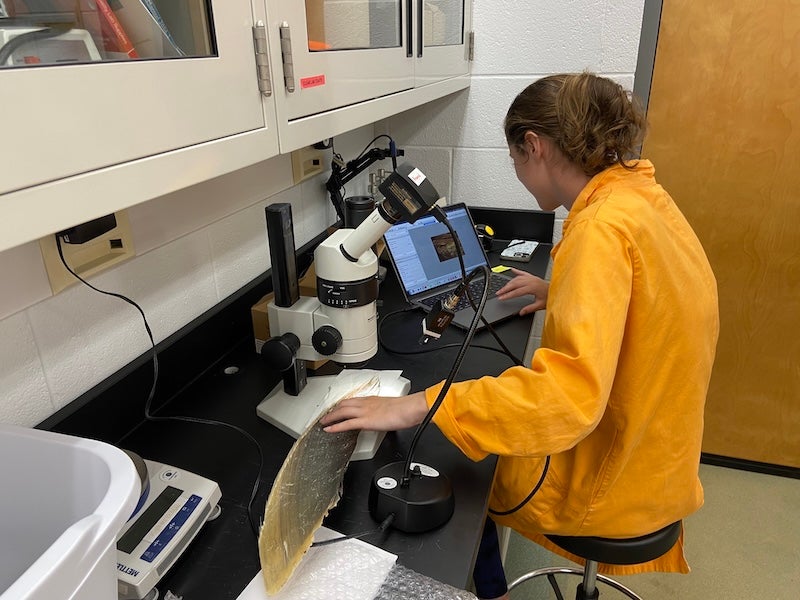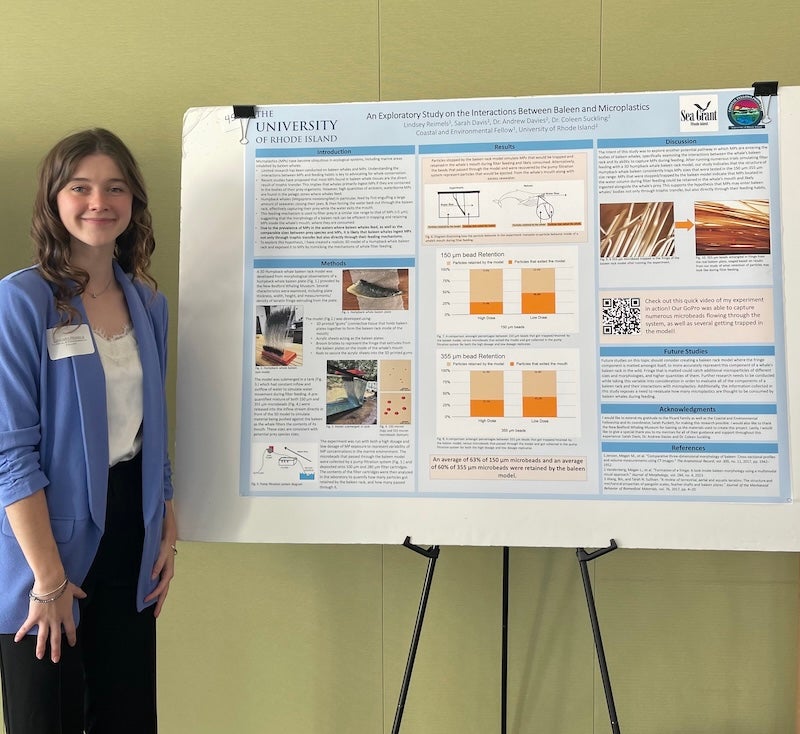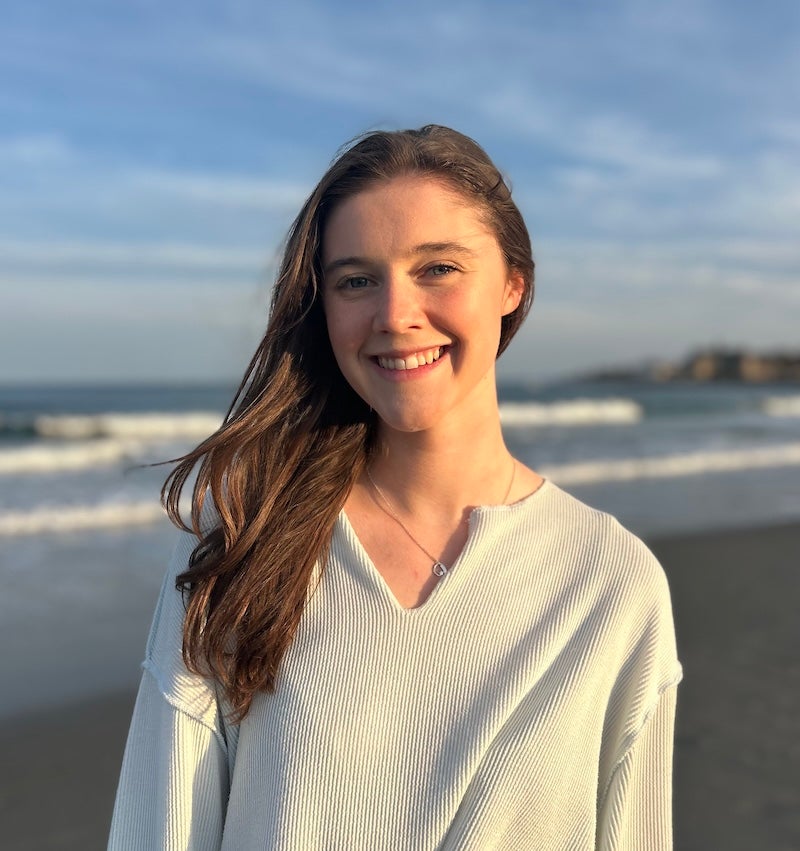Q. Why did you choose URI’s College of the Environment and Life Sciences?
Growing up in Tiverton, Rhode Island, I knew that URI had a large presence in marine science fields, particularly in climate change conservation. Topics like climate change and marine plastic pollution have always been an interest of mine, mostly due to witnessing plastic pollution on my hometown beaches. When it was time to choose a college, I knew I wanted to learn from URI experts on how to help solve these problems. As an animal lover, learning how these threats impacted marine life made the marine biology program a natural choice for me.
What opportunities did you pursue at URI? How did they enhance your education?
Ever since the spring of my sophomore year I have been a research assistant in Dr. Coleen Suckling’s Echinonerd Lab and Dr. Andrew Davies’ Marcotec Lab, as part of their plastic team. Here, I have helped Dr. Sarah Davis assess microplastic accumulation in Narragansett Bay, as well as with a trophic transfer study investigating the transport of microplastics between Eastern Oysters and Jonah crabs. Sarah’s paper on microplastic trophic transfer is currently in prep, and I am lucky enough to be the second author! Working with the lab team has brought me several hands-on learning opportunities in both the lab and the field, that has reinforced what I’ve learned in my courses and also has taught me new, robust research methods.

Throughout my time as a research assistant, I have continued working with the lab for the past two summers, first as part of the Coastal and Environmental Fellowship, and then as part of the RI NSF EPScOR SURF Program. Both of these opportunities allowed me to create and develop my own independent research project that focused on studying the relationships between baleen whales and microplastics. It is through these experiences that I learned I absolutely love creating, developing and evaluating research projects, which led to my decision to apply to graduate school. I am going to be continuing my research on baleen whales and microplastics at Old Dominion University this fall as part of their Ecological Sciences Doctoral Program! This would not have been possible without these research opportunities and the invaluable mentorship I have received.
What have been some highlights of your time in the Department of Marine Biology?
One of the highlights of my time as a marine biology student is getting to know and learn about our amazing faculty! As the marine bio program mentor, I’ve had the invaluable opportunity to sit down with and interview some of our amazing faculty members for the program’s monthly newsletter. Learning about each professor’s one-of-a-kind pathways into their current job, as well as their individual, innovative research has been nothing short of inspiring. I really enjoyed taking our meaningful conversations and featuring them in the newsletters so other undergraduates could get a better glimpse into the amazing work our faculty does!
What was your experience as a Marine Biology Program Mentor?
Serving as the Marine Biology Program Mentor has been one of the most rewarding experiences during my time at URI. When I was first told about the position, I did not hesitate at the opportunity to give back to the program that has given me so much. Being able to help grow and strengthen the marine biology program alongside Dr. Niels-Viggo Hobbs was both personally and professionally fulfilling. The highlights of this position include helping undergraduates source research opportunities, hosting program events, recruiting prospective students at open houses, and authoring monthly program newsletters.

Tell us about your research on the uptake of microplastics by baleen whales!
We know from necropsies that baleen whales are ingesting microplastics. Except, the exact pathways of this ingestion are still unknown. Baleen whales eat very small prey items, such as krill, using a complex filtering mechanism called the baleen rack. Interestingly enough, characteristics of krill overlap with the sizes and morphologies of microplastics, indicating that they may be consumed in a similar manner. My research aims to evaluate whether baleen whales are able to use their baleen rack to trap and retain microplastics inside their mouth, just like they do prey, therefore allowing them to ingest microplastics directly through filter feeding.
I am studying this by building an in-lab filter feeding simulation which includes a three dimensional model of a Humpback whale baleen rack and a flume tank. By using this system, we are able to simulate the exact conditions of filter feeding in a controlled environment, and introduce microplastics into the system to see how they interact with the baleen rack model. Our preliminary research shows that retention by the baleen rack could be a direct pathway for microplastic consumption in baleen whales. When I finish this project, I am hoping to use it to help contribute to marine mammal conservation and plastic pollution mitigation!
What advice would you give to incoming or current students?
URI, particularly CELS, has so many opportunities available that you can use to build your skill set and get on track to achieving your post-graduate goals. Fellowships, leadership positions, advising, research opportunities etc., are all at your disposal, you just have to pursue them! Take advantage of as many as you can, and it will undoubtedly pay off!


